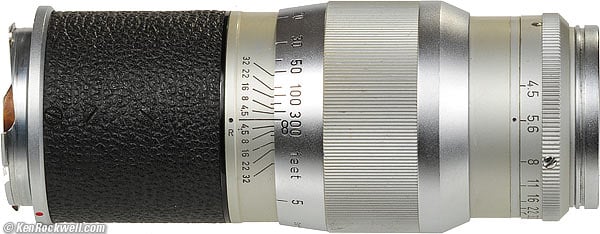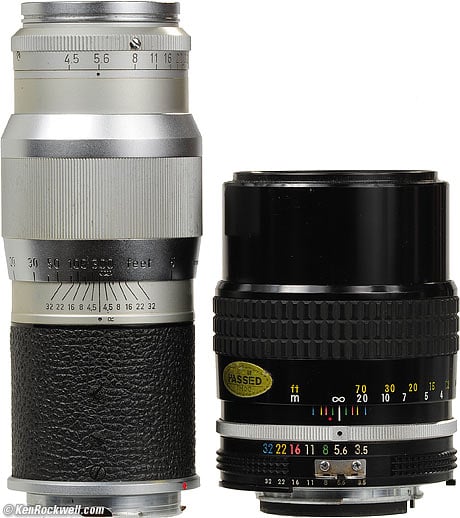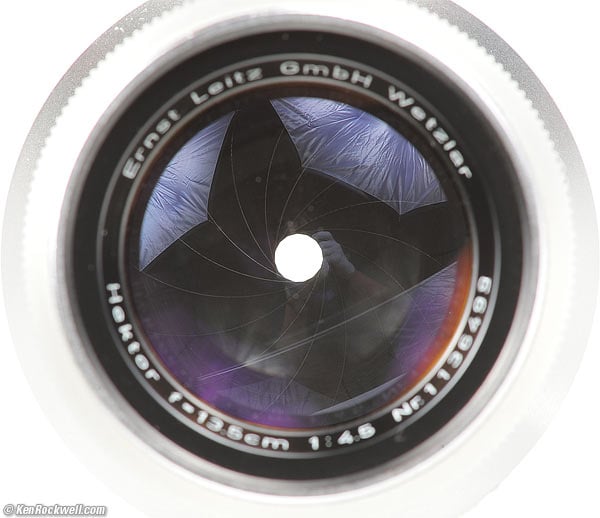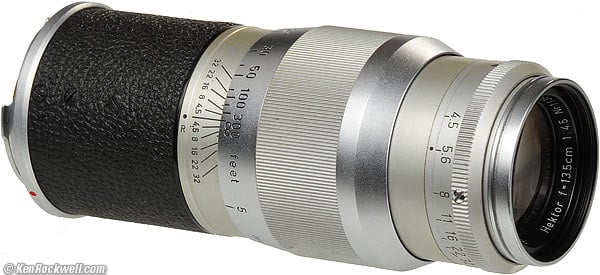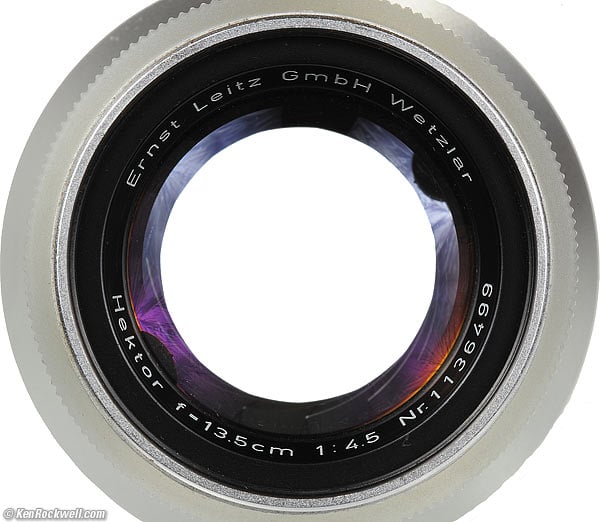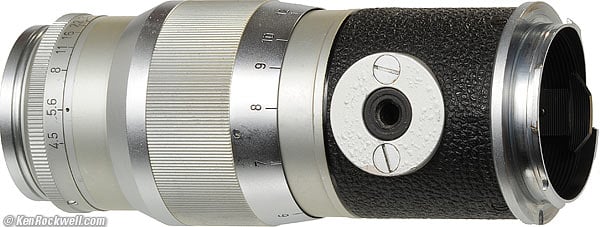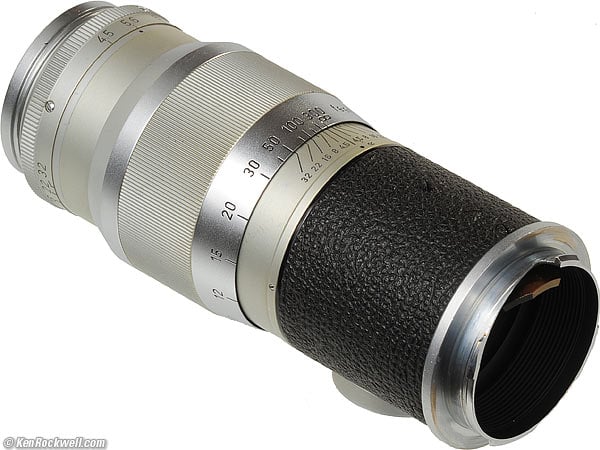Home Donate New Search Gallery How-To Books Links Workshops About Contact
Leica 135mm f/4.5
13.5cm Hektor (1933-1960)
© 2009 KenRockwell.com. All rights reserved.
Leica 135mm f/4.5 M (1956). enlarge. It helps me keep adding to this site when you use these links to Adorama, Amazon, B&H, Calumet, Ritz, J&R and eBay to get your goodies. Thanks! Ken.
February 2009
Leica Camera Reviews Leica Lens Reviews Recommended Lenses
Leica Lens Names How to Afford Anything
| Optics: | |
| Mechanics: | |
| Ergonomics: | |
| Usefulness: | |
| Availability: | |
| Overall: |
Introduction top
Intro Specs Performance Usage Recommendations
|
I personally buy from Adorama, Amazon, Ritz, B&H, Calumet and J&R. I can't vouch for ads below.
|
Leica has an almost 100-year history of making many of the world's very finest photographic lenses.
This isn't one of them.
This 135mm f/4.5 for the M bayonet rangefinder cameras has no distortion, very even illumination and superb bokeh, but it isn't very sharp except in the center. It's not a lens for precision nature and landscape shots, but it could be outstanding for people pictures.
This lens is best forgotten if you need super-sharp results, however for portraits wanting soft backgrounds, this lens is great. This one cost me only $59 over eBay.
It has a 15-blade diaphragm for perfectly circular openings at every setting.
This lens works perfectly on every Leica, and this M version works on everything from the M3 of 1954 to today's M7. In fact, the old M3 is probably the best body for this lens, because the M3 has the biggest finder of any M Leica.
The transitional half-frame Leica M8 and M8.2 probably has no finder lines for this lens, although it ought to work fine otherwise, seeing only the equivalent angle of view as a 180mm lens on a real Leica.
History
Leica's first 135mm lens was the f/4.5 Elmar of 1931, made through 1936.
This Hektor lens came out in 1933, and was made through 1960.
The lens shown here is an M lens made in 1956. Earlier versions came in many cosmetic variations, as well as in screw mount.
An f/4 135mm lens came out in 1960, and a telephoto design f/4 135mm came out again in 1965, which was made through 1995.
Specifications top
Intro Specs Performance Usage Recommendations
Leica Hektor 135mm f/4.5 and Nikkor 135mm f/3.5 AI. enlarge.
Optics
4 elements in 3 groups.
This is a conventional long lens design, not a telephoto. Its diaphragm sits right at 135mm from the image plane.
The Nikkor lens shown above is a telephoto design, and is much shorter.
Coating
Single-coated from 1946 starting at serial 590,551.
Uncoated before 1946.
Filter Size
39mm, 0.5mm thread pitch, exactly the same as Leica's best lenses, even today. (older models may vary).
Some Germans call this screw-in filter size "E39" or 39E," it's all the same 39mm filter thread.
Close Focus
4.9 feet (1.5m).
Diaphragm
15-blade circular diaphragm at f/32. enlarge.
This 135mm lens has a magnificent 15 blade diaphragm stopping down to f/32. (earlier versions will differ.)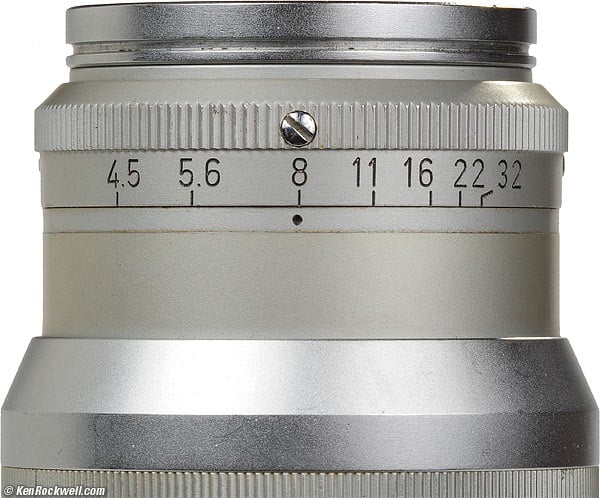
Aperture scale, Leica 135/4.5.
The aperture scale isn't linear. It gets crowded by f/22.
Size
Focused at infinity, it measures 5.019" from its flange and has a maximum diameter of 2.006" at its base (127.48 x 50.96mm).
The overall length is 5.278" (645.16mm).
This 135mm lens extends as focused more closely.
Weight
15.370 oz. (435.7g), measured as shown (naked; no caps).
16.205 oz. (459.4g) with original metal front cap and modern 14 269 rear cap.
Leica 13.5cm f/4.5. enlarge.
Performance top
Intro Specs Performance Usage Recommendations
Bokeh
This 135mm lens has wonderful bokeh. Out-of-focus backgrounds simply disappear, with no distractions, noise or hard edges.
The completely circular diaphragm keeps blur circles as circles, and not polygons, at every aperture.
Don't let the slow f/4.5 rating fool you. This 135mm lens throws backgrounds as far out of focus as a 90mm at f/2.8 or a 50mm at f/1.7.
Diaphragm Linearity
My M7 agreed exactly as I tried every click stop.
Distortion
There is no distortion.
Straight lines stay ruler straight as tested at both infinity and at 10 feet (3 meters).
This is a benefit of the simple, non-telephoto design.
Falloff
There is no falloff. The corners don't get darker, even wide-open, another benefit of traditional design.
Filters
Standard 39mm filters screw right in.
Nothing rotates except for the focus and aperture rings, so it's easy to use grads and polarizers. Look through the filter, note its position, and screw on the filter paying attention to the position of the lettering around its perimeter.
Focus
Focus is smooth, but more damped (stiffer) than Nikon manual-focus SLR lenses. I prefer the Nikkors.
The triangularly serrated focus ring doesn't give traction as good as the current Leica square-tooth focus and aperture rings.
Lateral Color Fringes
I didn't see any, but it's a pretty soft lens which would tend to hide them.
Mechanics and Construction
15-blade circular diaphragm at f/5.6. enlarge.
The Leica 135mm f/4.5 is made as well as anything.
Filter Threads: Metal.
Identity Ring: Engraved and filled metal inside filter ring.
Serial Number: Engraved and filled on identity ring.
Barrel: Chromed metal and silver-painted metal. In my photos here, the paint is the greener-looking stuff. Compare this to the 1960-1965 135mm f/4, which is all chrome and no paint.
Base of Shaft: Fake leather for excellent grip when mounting and unmounting.
Focus and Aperture Rings: Chromed metal.
Focus Scale: Engraved in feet only, with index lines. Marked at 5,' 6,' 7,' 8,' 9,' 10,' 12,' 15,' 20,' 30,' 50,' 100,' 300,' and infinity. Additional unlabeled lines for 40,' 80' and 200.'
Focus Ring Rotation: 330.º
Focus Helicoids: Aluminum and brass.
Other Internals: Metal.
Mount: Dull chromed brass.
Mounting Index: Engraved red dot.
Markings: Engraved and filled with paint.
Sharpness
This is among the softest lenses I've used.
The center is OK, but at larger apertures the sides turn into blurry messes.
At f/4.5, the center is sharp, but the sides are blurred as if the camera had been rotated. More technically, the saggital and meridional MTF curves diverge.
At f/5.6, the sides remain softer, but improve to being generically soft instead of outright blurred.
Thing are OK all over by f/8. but forget about hand-holding this with slow film.
This lens faked me out: I was expecting it to work great, since other, simpler German lenses have performed quite well, but not this lens.
Because of this I only shot it at f/4.5 and f/5.6, which is where you have to shoot a lens like this if you're going to hand-hold it with film.
I haven't yet tried it at tripod-only apertures of f/8 and smaller, where its performance ought to improve greatly. By f/8 in daylight with ISO 50 film, you'll be wanting a tripod, and I suspect f/11 to f/16 may be the optimum apertures for this lens.
Usage top
Intro Specs Performance Usage Recommendations
Tripod Socket
Leica 135/4.5 Tripod Socket. enlarge.
There's a tripod socket on the bottom. This 1956 lens has a 1/4" thread.
This is a light lens, but when you remember that Leica cameras have no real tripod sockets, just threaded inserts attached to the sheet metal of their removable bottom covers, the Leicas can use all the help they can get to keep you from banging the lens accidentally and bending the bottom cover.
Depth of Field Scale
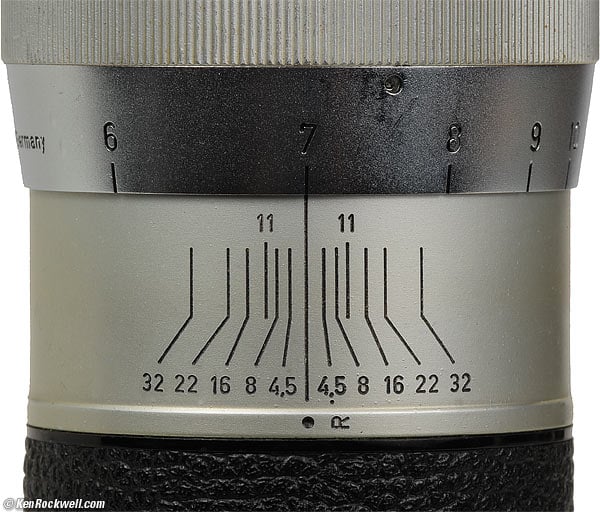
Depth of Field Scale.
The depth of field scale holds a surprise: the f/11 numbers wouldn't fit in the usual spot, so Leica hid them above the scale where they won't appear until you focus as close as about 9 feet.
The lines corresponding to f/11 are always visible, but you'll only see them called out for f/11 as you focus closely enough so that the lines no longer reach the focus scale. The focus scale leaves the field lines as you focus closer than 10 feet.
There is an infra-red index at the f/4.5 mark.
Rear, Leica 13.5/4.5. enlarge.
Recommendations top
Intro Specs Performance Usage Recommendations
For photos of people, this inexpensive lens could be the ticket for cheapskate Leica shooters.
Don't get it if you need sharp, but if you know what you're doing, this bargain-priced lens could last you a lifetime — and beyond.
Deployment
I'd use a 39mm 81A B+W brand filter for slide film.
I'd use any 39mm B+W brand yellow filter for B&W film outdoors, or a 39mm Leica brand 13 131 UV filter indoors.
I'd use a 39mm Leica brand 13 131 UV filter for color print film, but why would anyone shoot color print film in a Leica?
I wouldn't bother with a digital Leica until they come out with a full-frame body, and even then film is more fun, but that's just me. I'm told digital shooters today need to use a Leica brand 39mm UV/IR filter 13 410 (or a B+W brand 39mm UV/IR filter) to correct for a design flaw in the M8.2's sensor system design. Caution: THe M8 has no finder for 135m lenses, you'll need an external viewer! For the M8, use the goggled Leica 135mm f/2.8.
PLUG
I support my growing family through this website.
If you find this as helpful as a book you might have had to buy or a workshop you may have had to take, feel free to help me continue helping everyone.
If you've gotten your gear through one of my links or helped otherwise, you're family. It's great people like you who allow me to keep adding to this site full-time. Thanks!
If you haven't helped yet, please do, and consider helping me with a gift of $5.00.
The biggest help is when you use any of these links when you get anything. It costs you nothing, and is this site's, and thus my family's, biggest source of support. These places always have the best prices and service, which is why I've used them since before this website existed. I recommend them all personally.
Thanks for reading!
Ken
Home Donate New Search Gallery How-To Books Links Workshops About Contact

